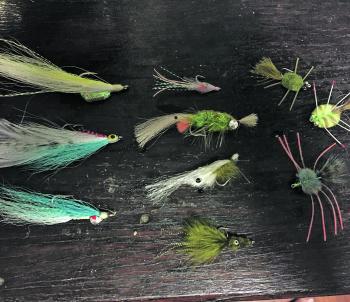Flyfishing is a very technical type of fishing and is used all around the world. Flyfishing is when an angler uses a hand-tied fly with little to no weight.
Specialised casting techniques are used with flies, as they are very light. Long rods and weighted lines are needed for this type of fishing to have the ability to cast. These long rods and weighted lines act like a whip when you are casting a fly.
People seem to believe that flyfishing is only used in freshwater for species like trout. Flyfishing can be used in both fresh and salt water. From walking a small stream chasing trout to casting large flies at pelagic fish, flyfishing can be used anywhere.
The variety of fish that can be caught using flies can vary from a rainbow trout to an angry longtail tuna! The species that I have been targeting on fly have been flathead and bream. Flathead love a well-presented fly and can give you a quality fight on the fly gear at any size.
Flies made by fastening hair, fur, feathers or any other materials that can be both natural and synthetic onto a hook. Flies are generally tied to a single hook and range in size from a size 10 hook all the way to a strong 6/0. They’re are broken up into two separate groups, wet and dry flies.
Wet flies are designed to sink and often have a small weight to allow them to sink under the surface. Dry flies are flies that sit on the surface of the water with no weight added – just a hook and some material. Flies tend to replicate an insect, shrimp, baitfish and even things like small frogs.
Gear choice is an important factor in catching fish on fly. There is no point having a tuna setup if you’re only chasing bream. Fly rods are categorized in weights instead of kilos or pounds, which a normal rod would have. The fly combo I use for chasing bream and even flathead is a small 5wt, 8ft rod with a reel to suit.
Fly-wise, I tend to carry a few different styles on me, which are small shrimp, crab and baitfish patterns. For bream, I tend to like flies on a size 4 hook and a little bit larger for flathead, around the size 1. A 6lb tippet is a good starting point when targeting bream and use something around 8lb for flathead.
Flyfishing is a highly technical form of fishing and I hope these few tips give you an insight into flyfishing and how it works. Flyfishing is something everyone should have a go at, even if you don’t catch a lot of fish. There is always something new to learn when fishing. This type of fishing is new to me, and I’m learning new things every time I get out for a fish.
If you want more info or to ask me any questions, come into Dave’s Bayside Bait and Tackle in Victoria Point and we are always happy to have a chat. Until next month, tight lines and screaming drags.
Reads: 4035
Jack Burling with a bream caught on a small bread fly.

The author’s basic fly combo.

A small selection of flies including small shrimp, crab and baitfish patterns.




